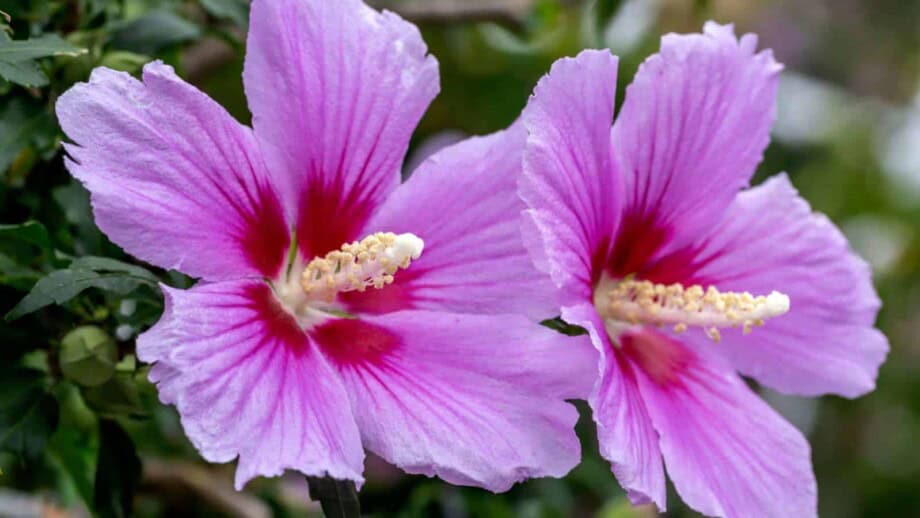The Rose of Sharon, scientifically referred to as Hibiscus syriacus, is an ornamental shrub that belongs to the mallow or Malavaceae family. As a species aptly renowned for showy flowers, the blooms produced by this specimen are a picturesque spectacle beloved by gardeners.
Best suited for placements in landscape designs that receive copious amounts of direct sunlight, this hardy plant is loved not only by humans but also a variety of pollinators such as bees, butterflies, and hummingbirds attracted to the shrub’s flowers.
Boasting a variety of colors from white flowers to lavender and pink double flowers, Rose of Sharon is a reliable choice for gardeners who appreciate a flourish of color in their gardens.
They not only find their place as standalone specimens but also function as part of a hedge or foundation planting due to their upright habit. The impressive display of blooms saturates the shrub during midsummer, introducing an explosion of color just as many shrubs and plants start to fade.
Rose of Sharon is well suited for a broad range of soil types but thrives in well-drained soil. They can withstand poor soil conditions and periods of drought, making them a resilient choice for areas prone to these circumstances.
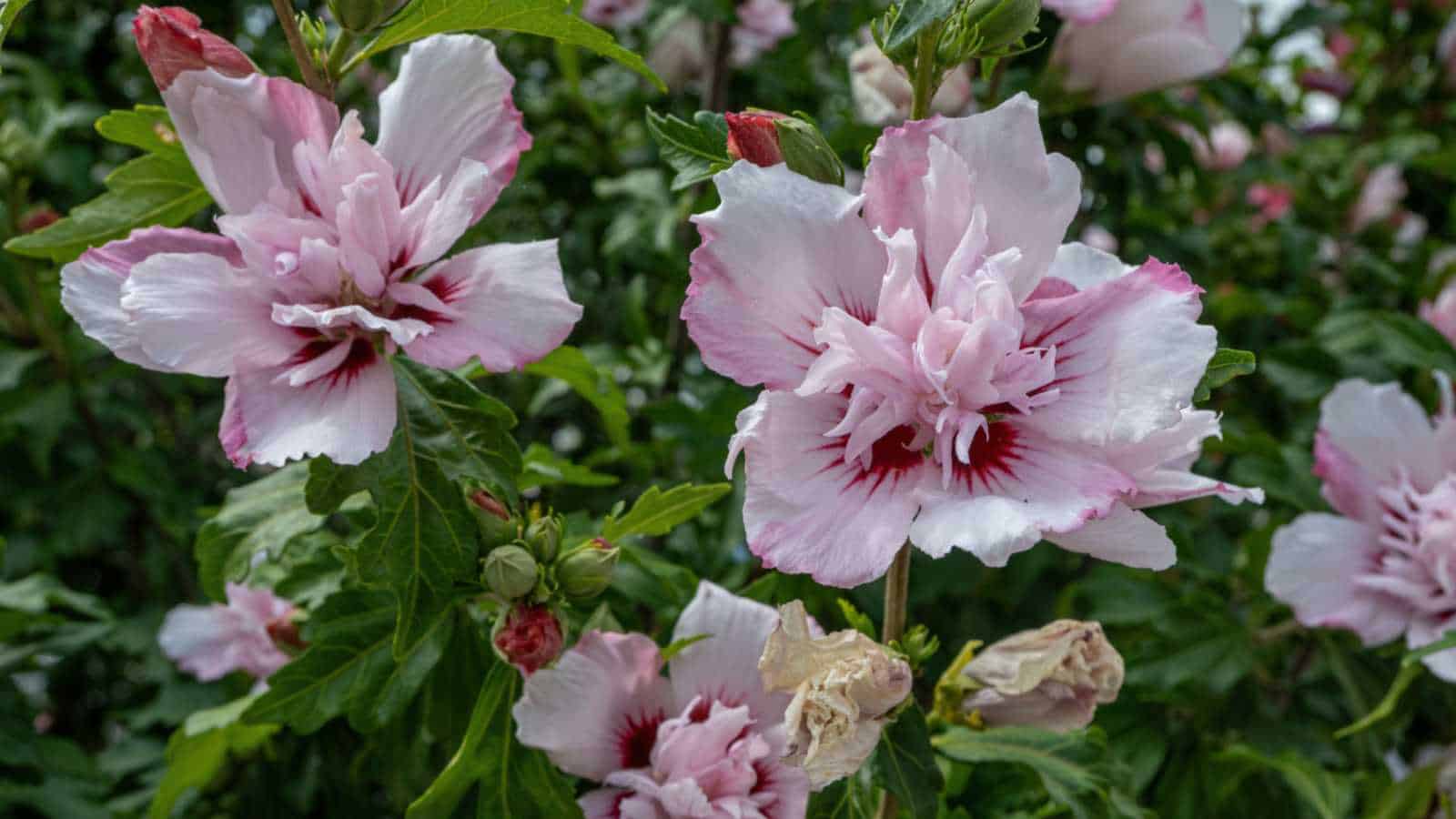
Despite their hardy characteristic, it’s advisable to incorporate some compost to enhance soil moisture and a slow-release fertilizer, particularly in early spring to encourage the formation of flower buds.
Interestingly, the Rose of Sharon self-seeds abundantly, leading to plenty of seedlings around the parent plant. It can certainly fill an area quickly with its progeny, providing gardeners with a natural, self-propagating burst of beauty year after year.
Even so, the shrub has been known to transfer some of its beautiful traits onto its newborn kin, providing the gardener with a somewhat unpredictable, yet appreciated variety of visual treats.
As a master gardener, I’ve been able to grow these stunning plants many times throughout the past decade. In this article, I’ll go over everything you need to know about Rose of Sharon, including its plant care requirements and how to plant and propagate it.
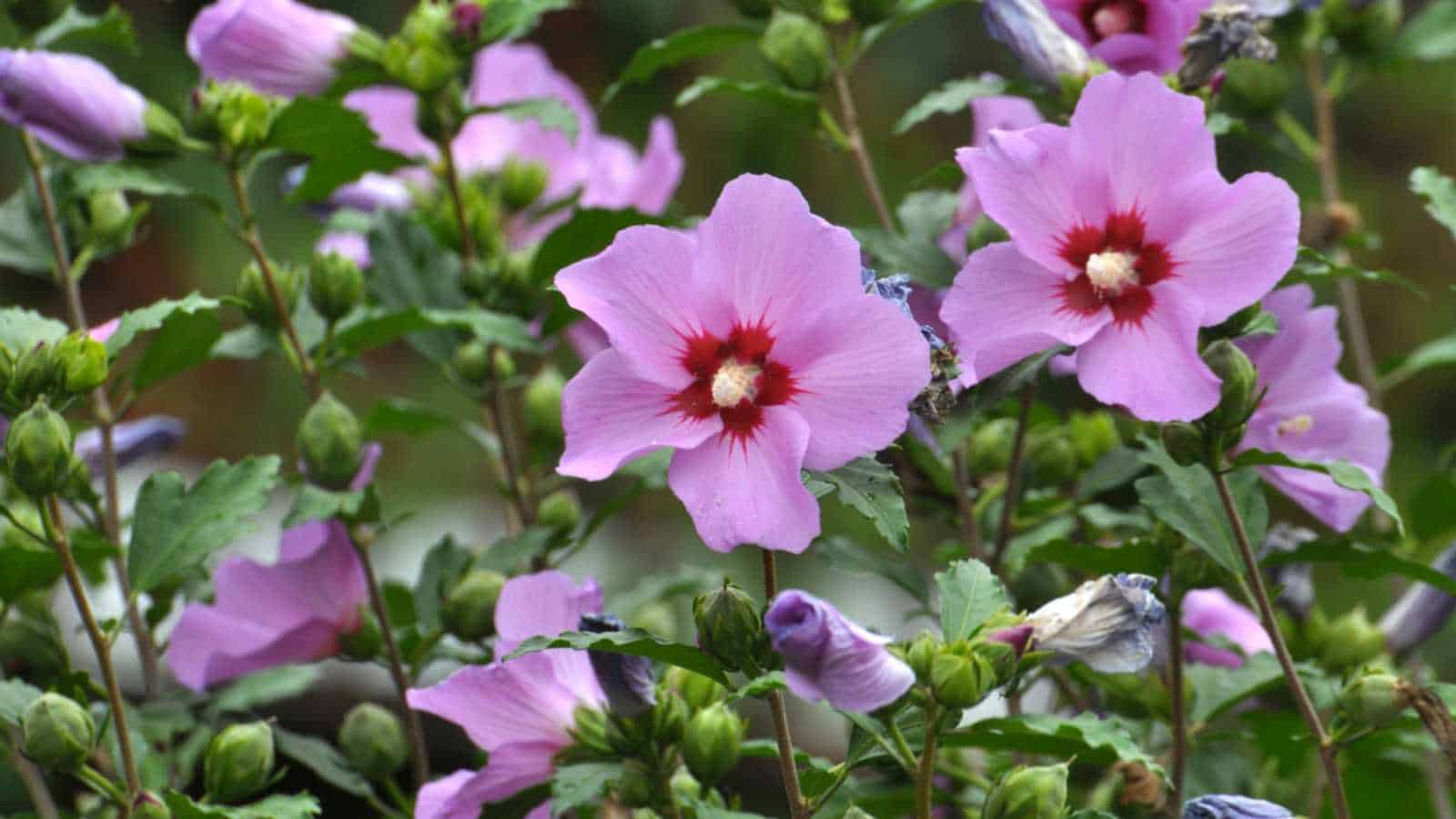
Botanical Name: Hibiscus syriacus
Common Name: Rose of Sharon, shrub althea, rose mallow, Syrian mallow, Syrian hibiscus
Family: Malvaceae
Plant Type: Shrub
Hardiness Zones: 5 – 8 (USDA)
Sun Exposure: Full, partial sun
Soil Type: Moist, well-drained
Soil pH: Acidic, neutral
Bloom Time: Summer, fall
Flower Color: Pink, purple, lavender, red, blue, white
Native Area: Asia
Rose of Sharon Plant Care
The rose of Sharon, also known as hibiscus syriacus, is a hardy shrub loved by master gardeners for its showy flowers, which can be pink double flowers, lavender, or white flowers that eagerly blooms in full sun throughout midsummer.
As a member of the Malvaceae, or mallow, family, this specimen loves well-drained soil but is tolerant to poor soil and somewhat resistant to drought.
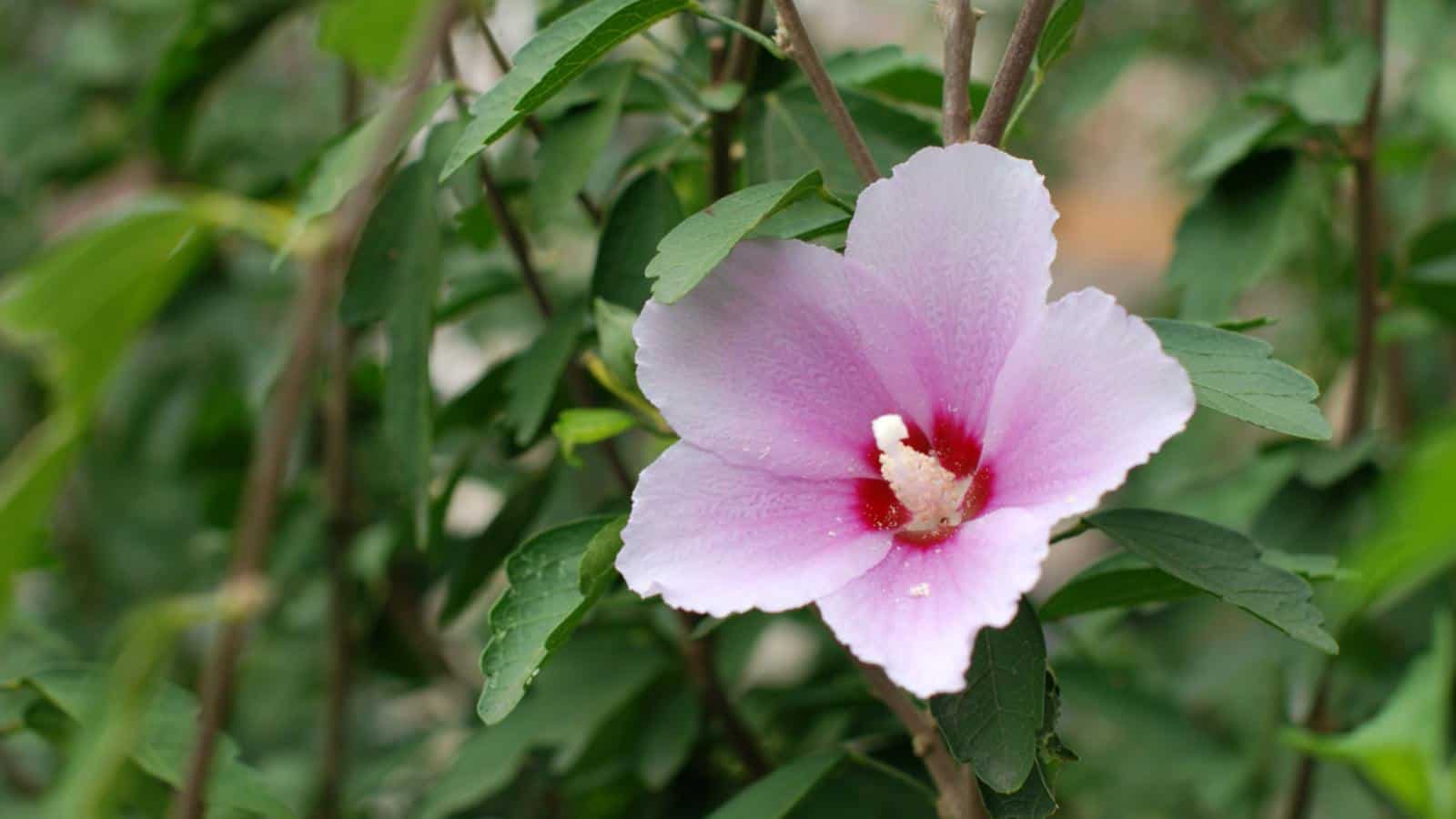
Regularly feed your rose of Sharon a slow-release fertilizer in early spring, and keep a careful eye on soil moisture. It is drought-resistant but thrives best when the root zone is consistently moist without suffocating the top of the root ball or creating air pockets.
Watch for pests like aphids that can damage the foliage and flower buds on this shrub, and when breaches occur, take action to ensure the shrub’s flowers retain their luxuriant bloom.
Light
The Rose of Sharon is a versatile and hardy shrub that thrives in full sun. An adequate amount of light can help bring forth the shrub’s double flowers, featuring shades of lavender, pink, white, and more that bloom from midsummer through fall.
Ideally, it needs at least six hours of direct sunlight daily for maximum blooming potential. While it can tolerate partial shade, too little sun may result in fewer blooms.
Hence, location planning for this mallow relative should ensure that it has the necessary light exposure to support healthy foliage and generous flowering habit.
Soil
Rose of Sharon thrives best in well-drained soil. Regardless of the soil type, be it poor soil with scarce nutrients or rich fertile soil, it adjusts efficiently.
However, to promote healthier specimen and bloom production, enrich the soil with compost or a slow-release fertilizer preferably in early spring.
Ensuring soil moisture during periods of drought is also beneficial though the shrub althea can withstand dry spells. This hardy shrub deeply appreciates not overly waterlogged soils, as it prefers consistent moisture without getting its roots water-soaked.
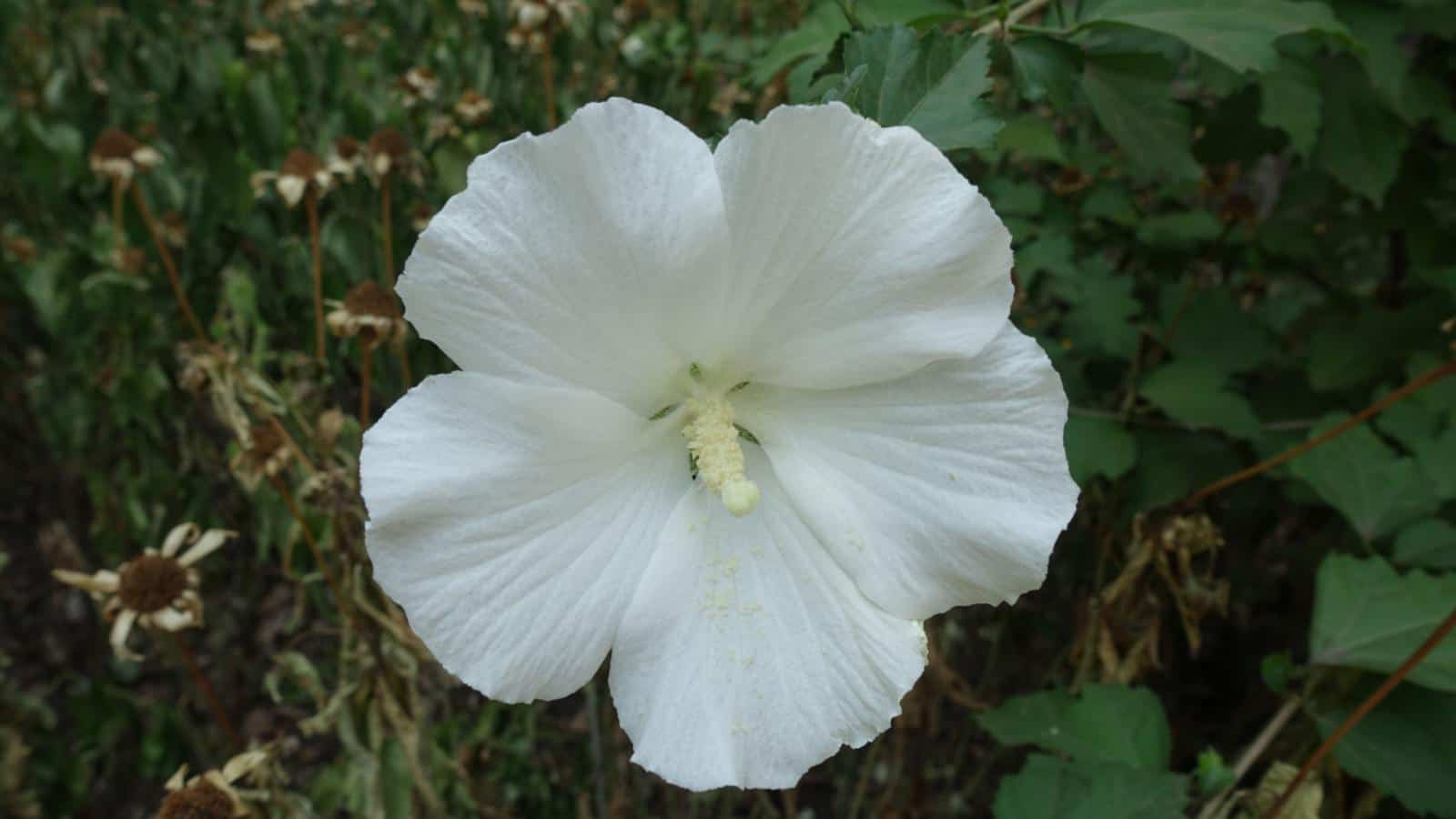
Water
Watering requirements for the rose of sharon are simple yet crucial. This hardy shrub prefers well-drained soil, to avoid any chance of root damage that could be caused by excess soil moisture.
It can tolerate drought but performs best with regular watering that keeps the soil evenly moist, especially during midsummer when blooms are developing. During periods of high heat, watering deeply at the root zone is beneficial to ensure that the whole shrub is hydrated.
However, ensure that air pockets are eliminated during watering to prevent damaging the roots. Over-watering or under-watering could lead to a decrease in showy flowers or yellowing of the foliage.
As a rule of thumb, damp soil is desirable, whereas soggy or extremely dry soil is not.
Temperature and Humidity
Rose of Sharon can handle a wide range of temperatures, from hot, dry summers to colder winter conditions. However, these shrubs truly thrive best in places where they receive full sun – at least six hours of direct sunlight daily.
Despite their resistance to a variety of climes, Rose of Sharon appreciates a relatively high soil moisture level, though they can tolerate drought once properly established.
Moderately humid environments are beneficial for this plant, but it can also do well in areas of low humidity.
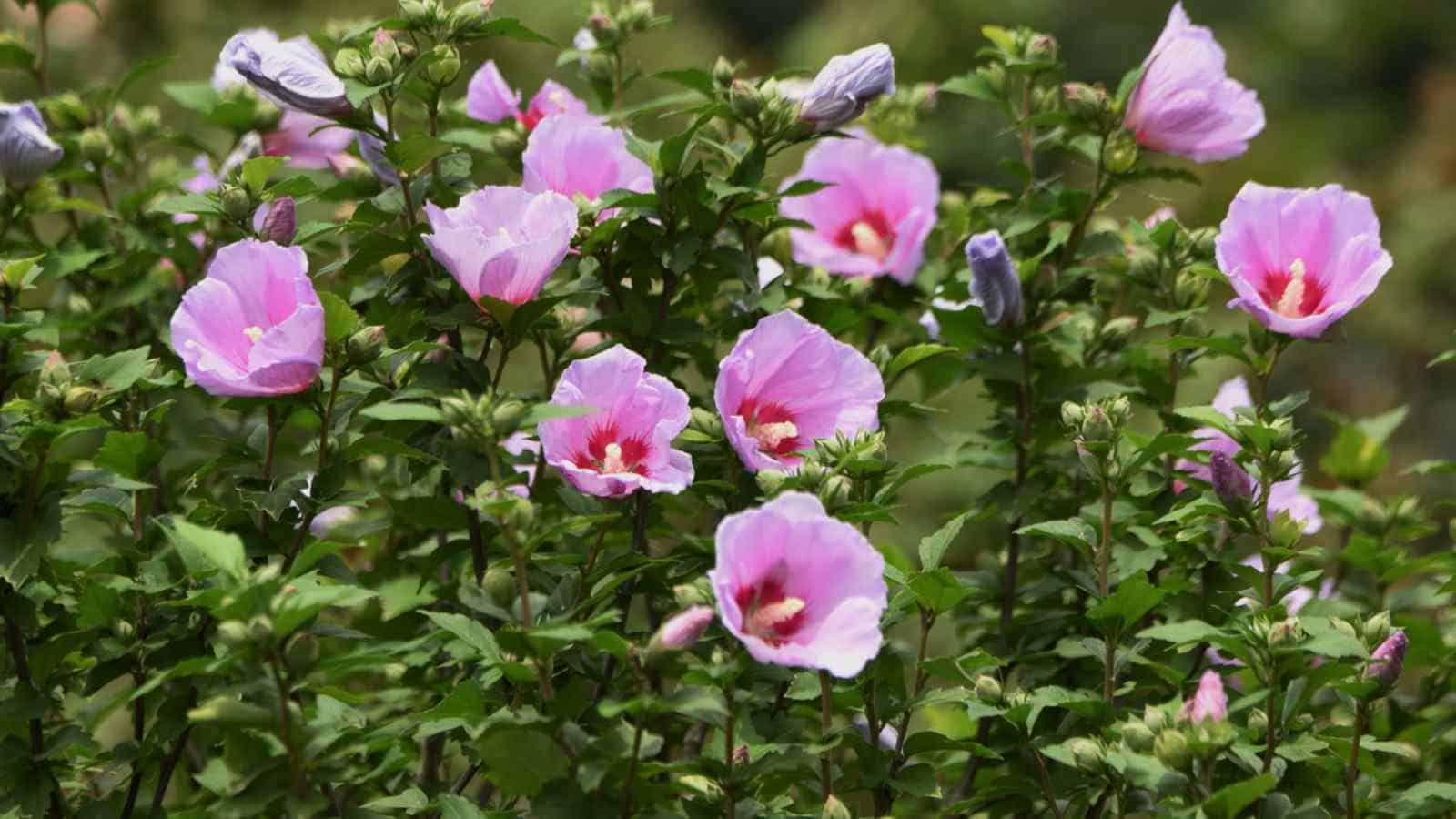
Fertilizer
Rose of Sharon requires a balanced, slow-release fertilizer for optimal growth. It’s ideal to apply fertilizer in early spring to kick start the growing season and to replenish any nutrients that may have been depleted over the cold, late winter months.
Enriching the soil with compost not only boosts soil moisture and structure but also aids in providing the necessary nutrients to maximize the shrub althea’s blooms.
Modest amounts of fertilizer are required, excessive feeding can lead to excessive foliage and fewer blooms. Always be sure to follow the label instructions on the fertilizer, excessively high concentrations can injure the plant.
Pruning
The Rose of Sharon benefits a great deal from pruning in the late winter or early spring. This shrub’s flowers blossom best on new growth; thus, pruning helps bring about a vibrant show of blooms in the midsummer.
Always ensure to remove any diseased or broken branches, as well as old wood that no longer flowers. Strategic pruning improves the habit of the shrub, encouraging a more open form that helps prevent diseases by increasing air circulation throughout the foliage.
Also, a light prune after the first flowering can stimulate the Rose of Sharon to produce a second flush of its beautiful mallow flowers in mid-summer.
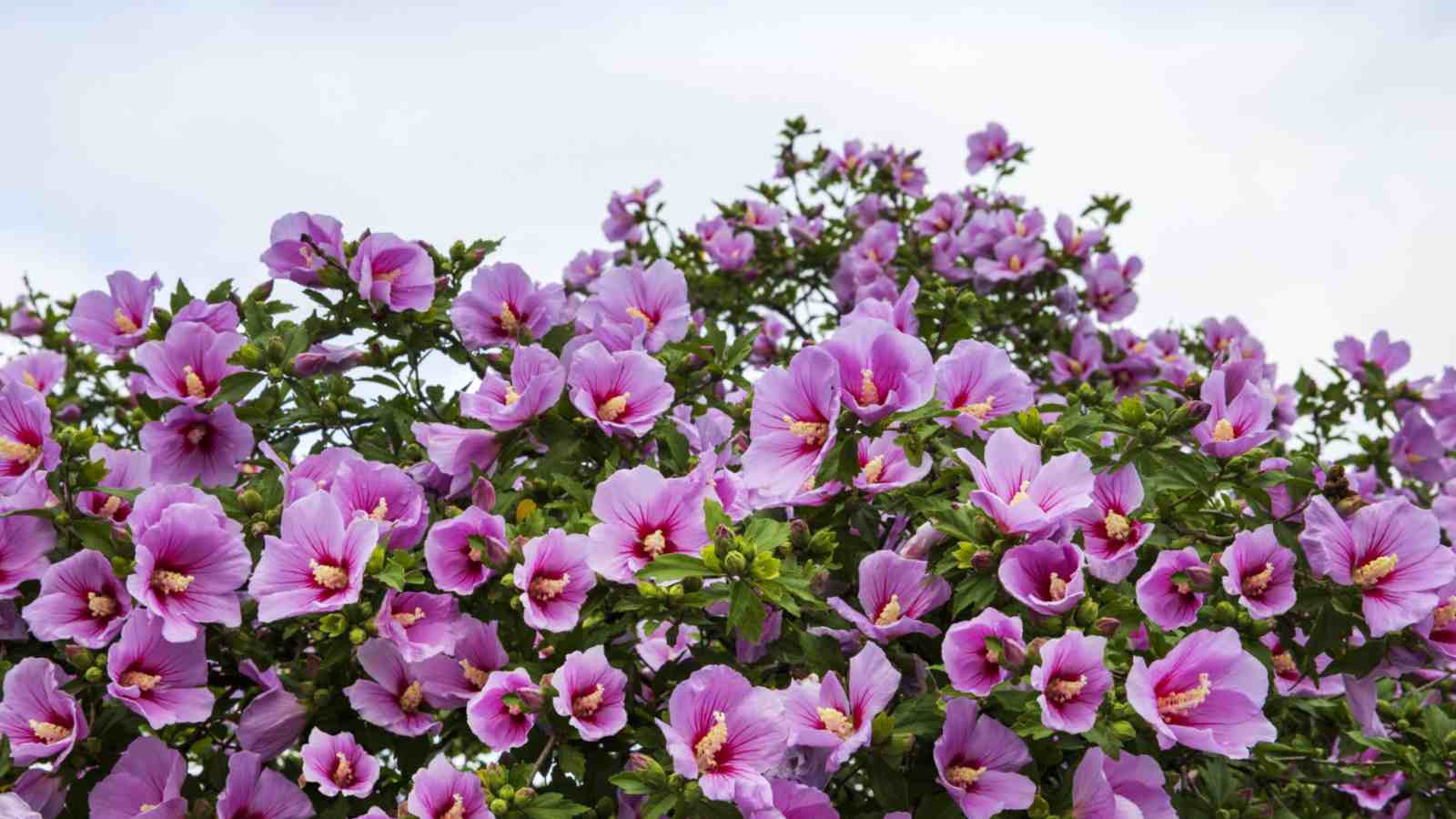
Overwintering
Though Rose of Sharon is known for being a hardy shrub, it does have specific overwintering requirements. To ensure its showy flowers bloom in midsummer, you must protect its flower buds, which form in late winter and early spring.
In areas with harsh winters, a layer of compost applied over the root zone can shield the plant. Pruning should be avoided until late winter to minimize damage from frosts.
Also, make sure your plant is well-watered leading up to freezing temperatures, as dry soil can make it more susceptible to cold damage.
Overwintering care for Rose of Sharon ensures that come mid-summer, your landscape will be enlivened by its large and alluring blooms.
Types of Rose of Sharon
- Blue Chiffon: Blue Chiffon is an exquisite type of hibiscus syriacus that sets itself apart with its blue double flowers. This specimen shows off its bright, showy flowers from midsummer to early fall, displaying a beautiful feast for pollinators such as butterflies, bees, and hummingbirds.
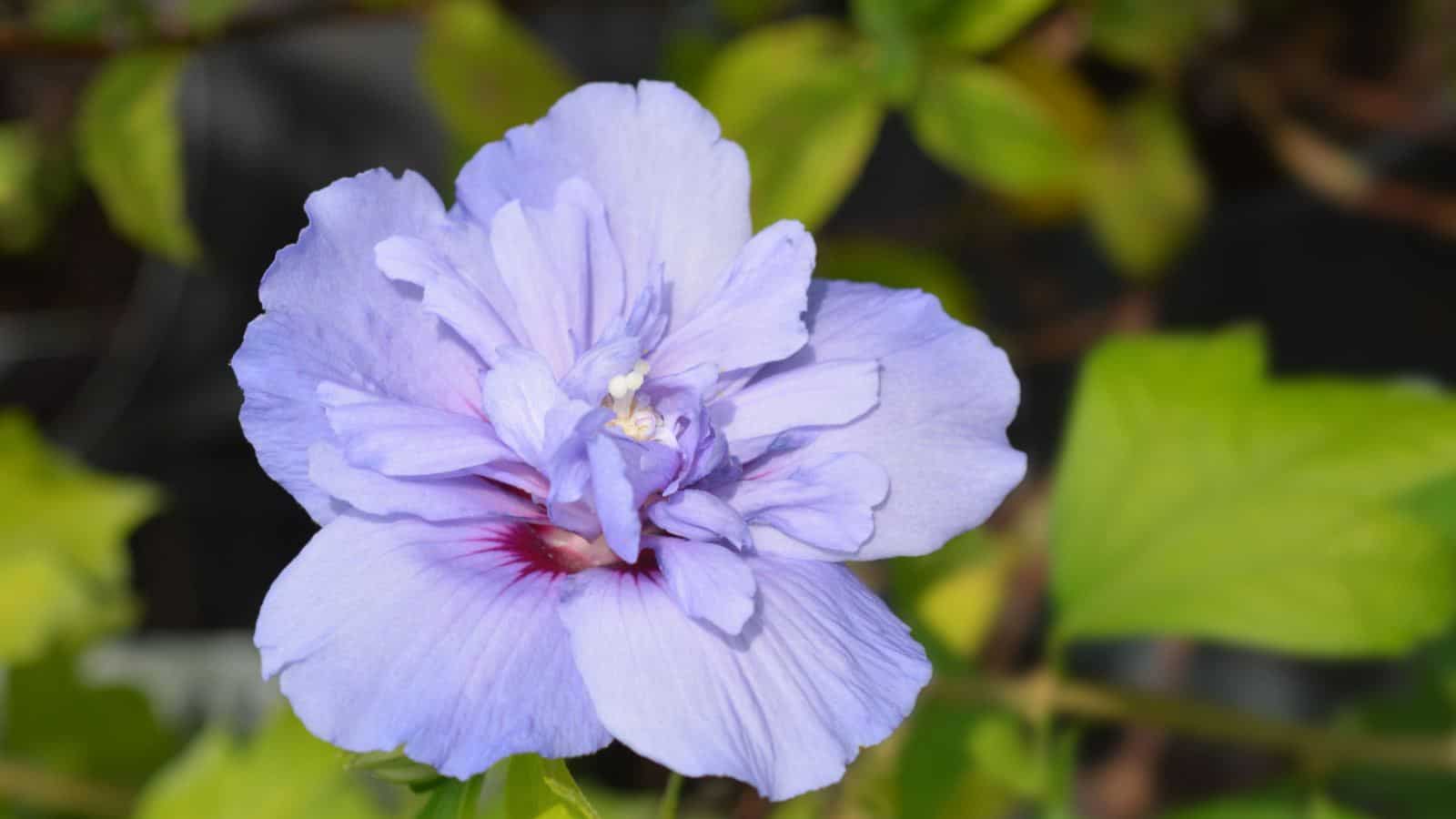
- Lavender Chiffon: Lavender Chiffon flaunts a neat habit of lavender double flowers. Appealing to butterflies and hummingbirds, this shrub’s flowers’ soft color adds a soothing touch to foundation planting schemes or hedge formations.
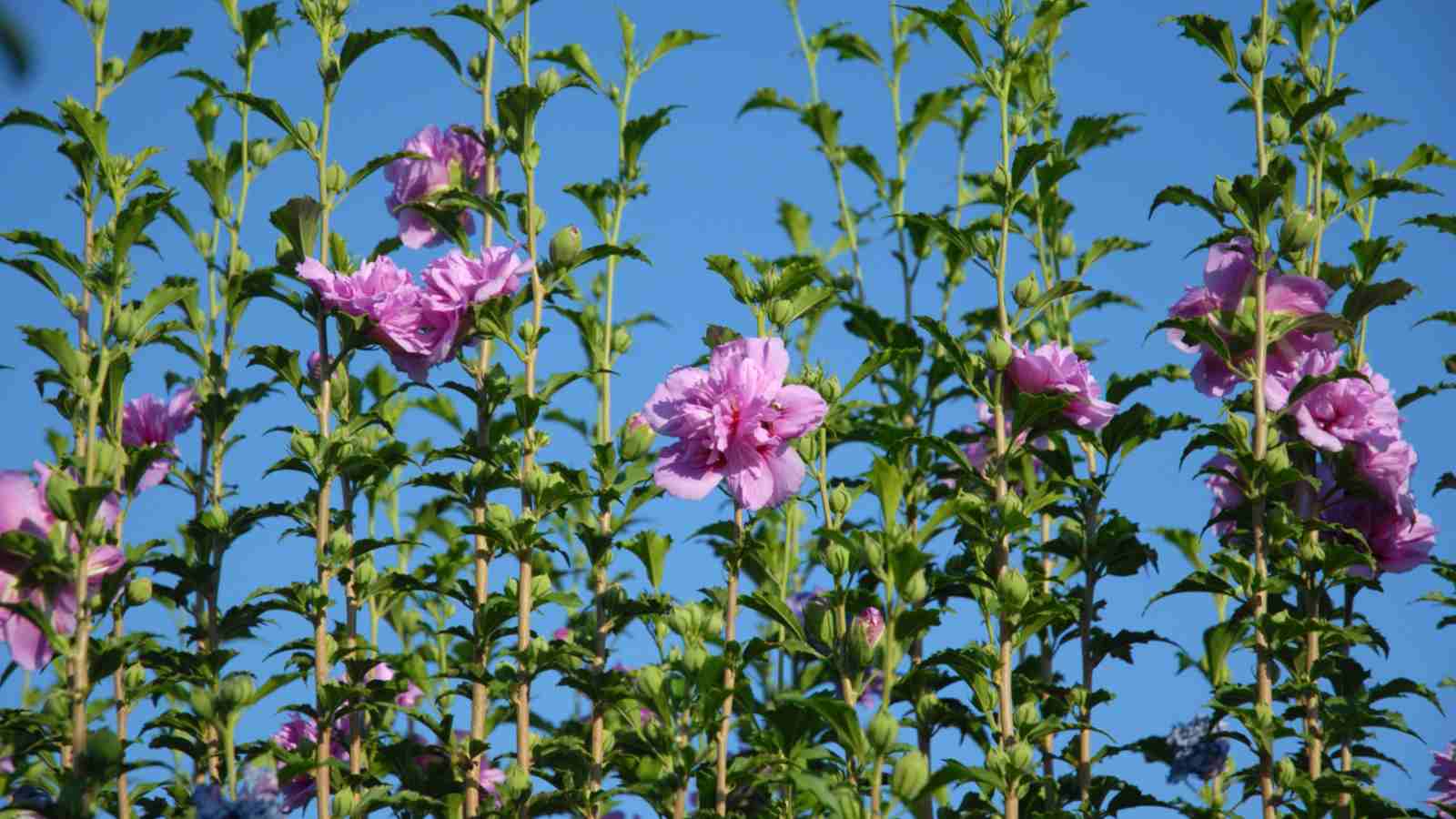
- White Chiffon: White Chiffon is known for its pure white double flowers. Blooming from midsummer to early fall, the shrub’s flowers attract a plethora of pollinators.
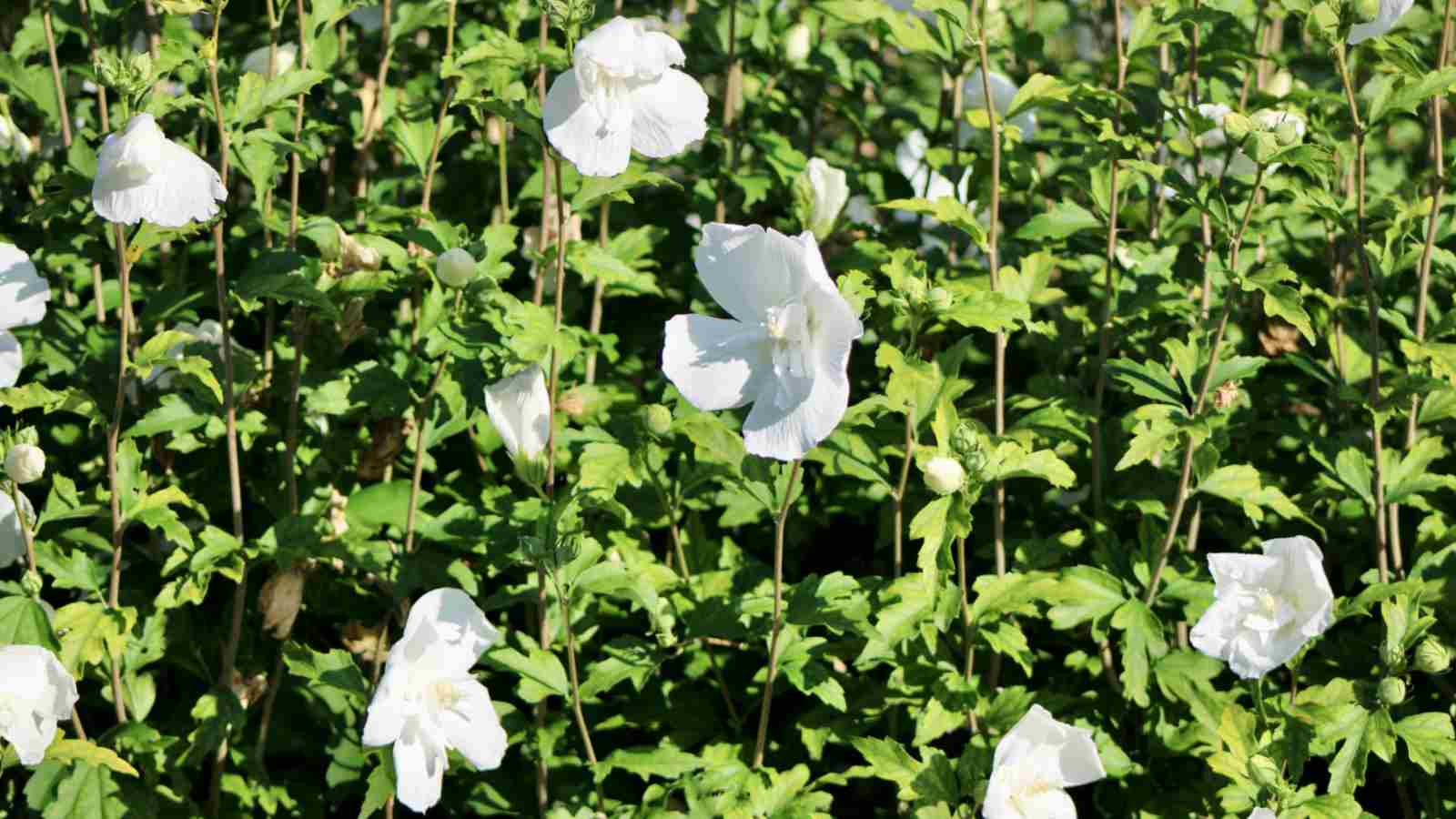
- Sugar Tip: Sugar Tip is recognized by its distinctive variegated foliage and pink double flowers. The shrub presents its alluring blooms from midsummer until early fall, drawing in a variety of pollinators.
- Helene: Among the hibiscus syriacus family, Helene distinguishes itself with its elegant white flowers with a prominent red eye in the center.

How to Plant Rose of Sharon From Seed
Acquiring the Seeds
After your Rose of Sharon produces showy flowers in midsummer, it will self-seed, dropping seeds that can be harvested. Look out for these near the shrub’s flowers. You can either let them naturally spread or collect these for later planting.
Preparing the Seeds
Rose of Sharon prefers a cold stratification process to encourage germination. In late winter or early spring, place your collected seeds in a labeled nursery pot filled with compost.
Place the pot into a cold frame or unheated greenhouse, and keep an eye on the soil moisture, letting the winter frost naturally prepare your seeds for planting.
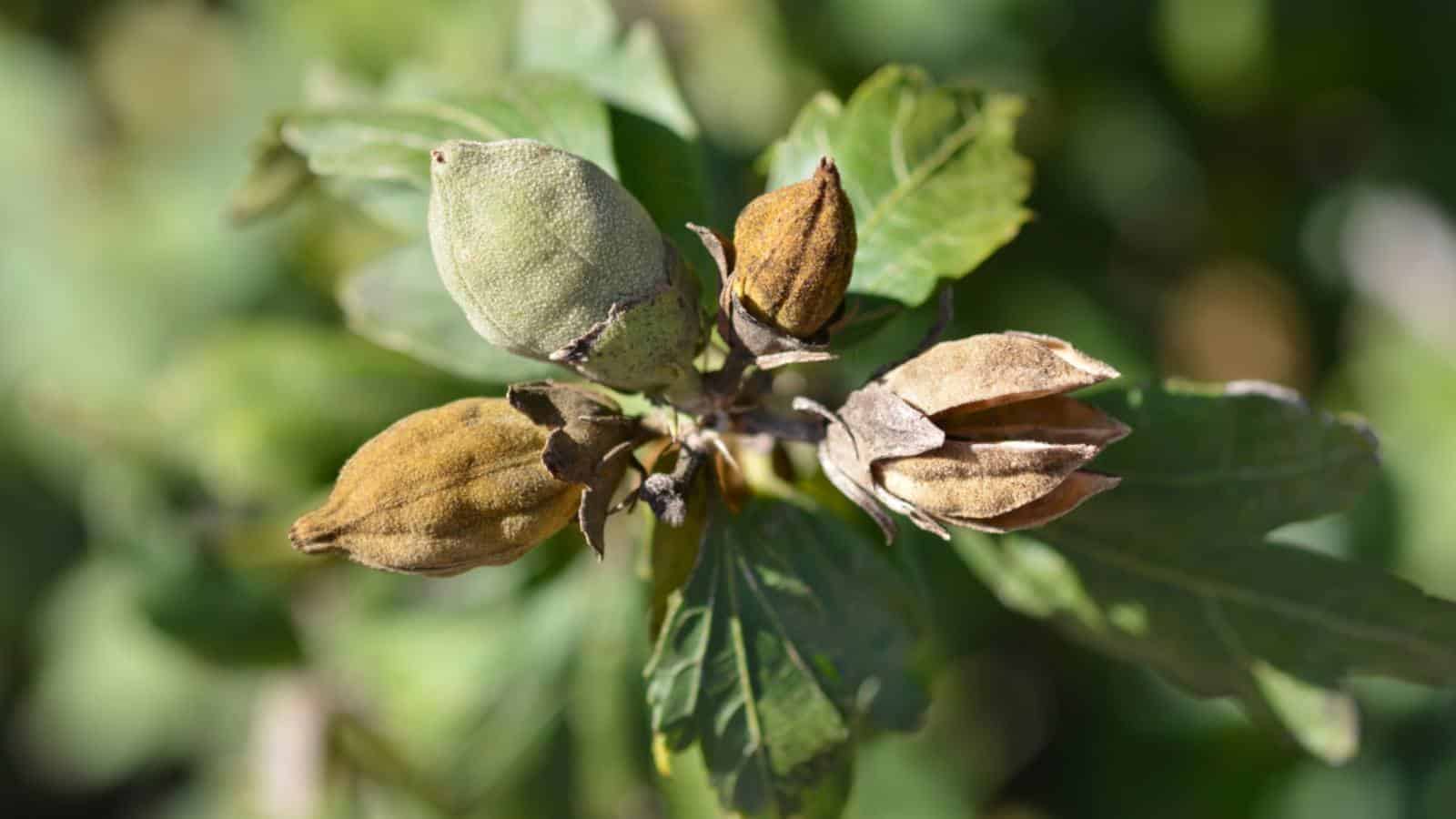
Germination and Planting Seedlings
By the time spring arrives, you should see your first Rose of Sharon seedlings. Allow these tender specimens to continue growing in these early stages.
Once all danger of frost has passed and the seedlings have developed a healthy habit–meaning they have several sets of true leaves–you can transplant them.
How to Propagate Rose of Sharon
Step 1: Choose the Right Specimen
Look for healthy, mature shrubs that produce vibrant blooms. The Rose of Sharon is known for its showy flowers, often lavender or pink double flowers, that attract pollinators such as butterflies, hummingbirds, and bees.
Also, double-check the label on the nursery pot to ensure it’s the preferred variety, as some types have unique characteristics, like white flowers or broader foliage.
Step 2: Take Stem Cuttings
Once you’ve found the perfect shrub, begin by taking stem cuttings. Do this in the mid-summer when the shrub’s flowers have already bloomed and the likelihood of disease and pests such as aphids is low.
Use a sharp, sterile tool to cut the desired length of the stem, preferably with a couple of leaves left on it. Strip away any flower buds while also leaving the top two leaves to ensure the cutting pours all its energy into rooting.
Step 3: Prepare the Planting Site
The Rose of Sharon enjoys full sun, requiring several hours of direct sunlight, and thrives best in well-drained soil. Prepare a suitably sunny spot in your landscape, adding ample compost to boost soil fertility and ensure optimal soil moisture.
Also, ensure that the site allows for good air circulation to reduce foliage diseases. Despite its love for full sunlight, this shrub also adapts well to partial shade.
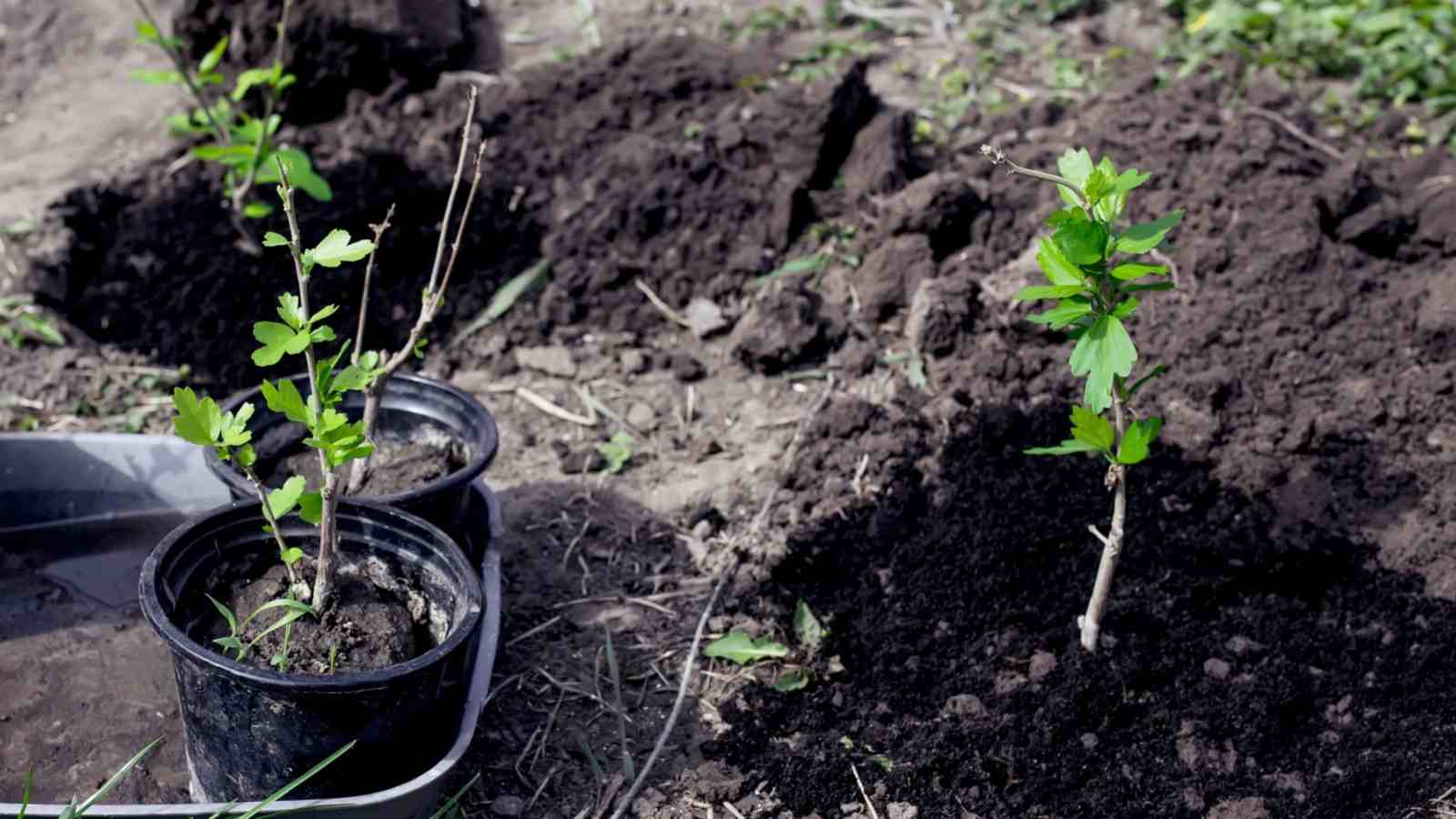
Step 4: Plant the Stem Cuttings
Plant the stem cuttings by making a hole deep enough to allow the top of the root ball to sit level with the surface. Be wary of the potential for air pockets and ensure you firm the soil sufficiently around the cutting.
Despite being a hardy shrub, the Rose of Sharon appreciates an application of slow-release fertilizer in the early spring to spur its growth.
Step 5: Care for the Newly Planted Shrubs
Rose of Sharon is fairly low-maintenance and can withstand poor soil conditions and drought. Nevertheless, regular watering, light pruning to develop a good habit, and controlling weeds within the first year of planting will ensure the shrub thrives.
In late winter, add mulch to keep soil moist and protect the root zone against temperature extremes. Be mindful that this shrub self-seeds easily, and prune off spent flower heads to prevent unwanted seedlings.
How to Pot or Repot Rose of Sharon
Step 1: Choosing the Correct Pot and Soil
Select a broad and deep nursery pot with adequate drainage holes. The soil should have a proper balance of soil moisture retention and drainage.
Enhance the quality of poor soil, if you have any, using a fine compost mix. It helps in providing the root zone with necessary nutrients.
Step 2: Potting the Plant
After preparing the soil and pot, gently remove your Rose of Sharon from its current pot. Be careful not to damage the top of the root ball.
Place the specimen in the new pot, ensuring it stands upright. Fill the surrounding area with your soil and compost mix.
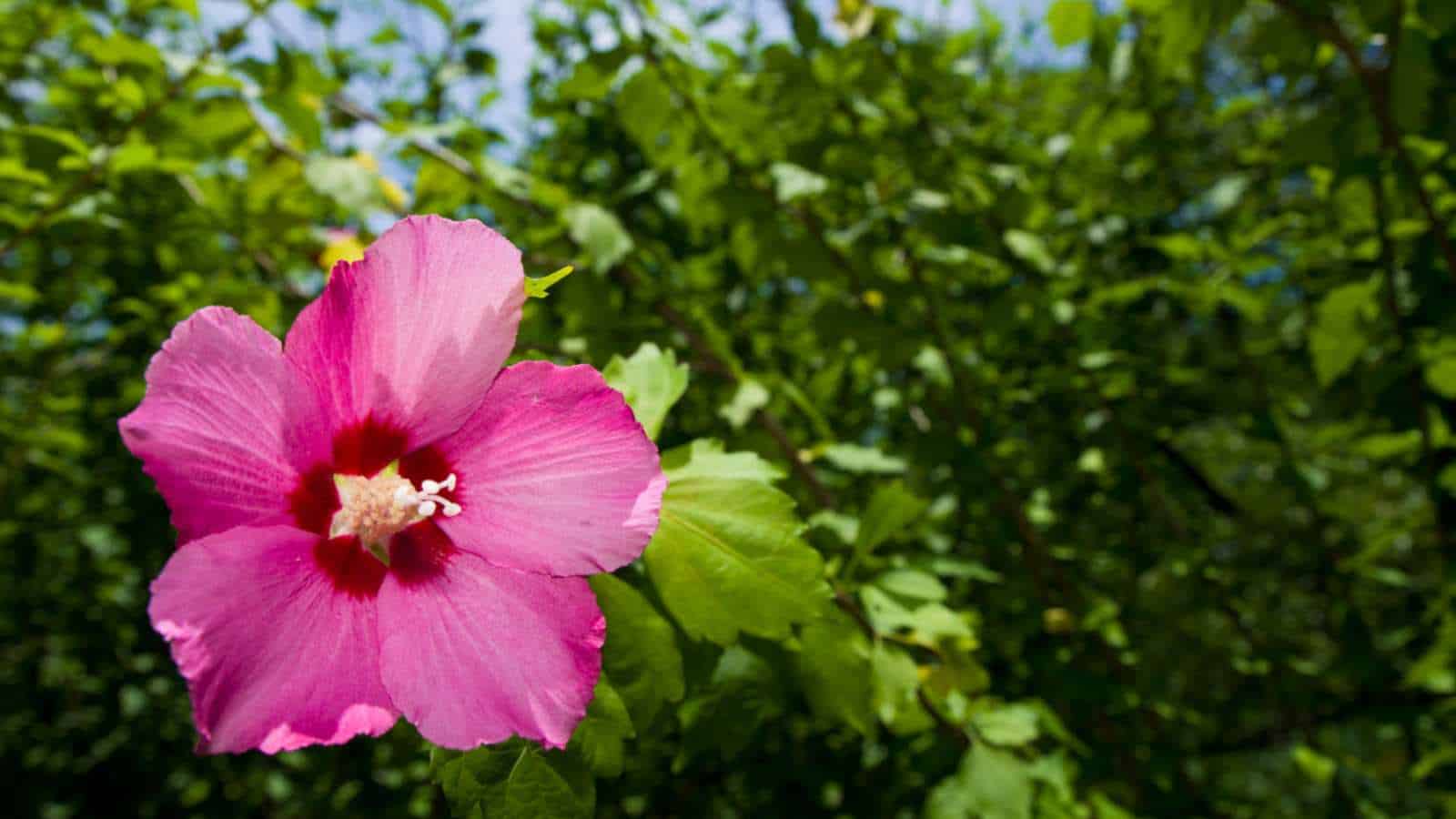
While doing this, make sure to eliminate any air pockets that may deprive the roots of much-needed water and nutrients by lightly tapping the filled pot.
Once planted, the soil around the shrub should be level with the top of the plant’s root ball. The soil label can often provide additional useful information if required.
Common Pests and Plant Diseases for Rose of Sharon
Aphids
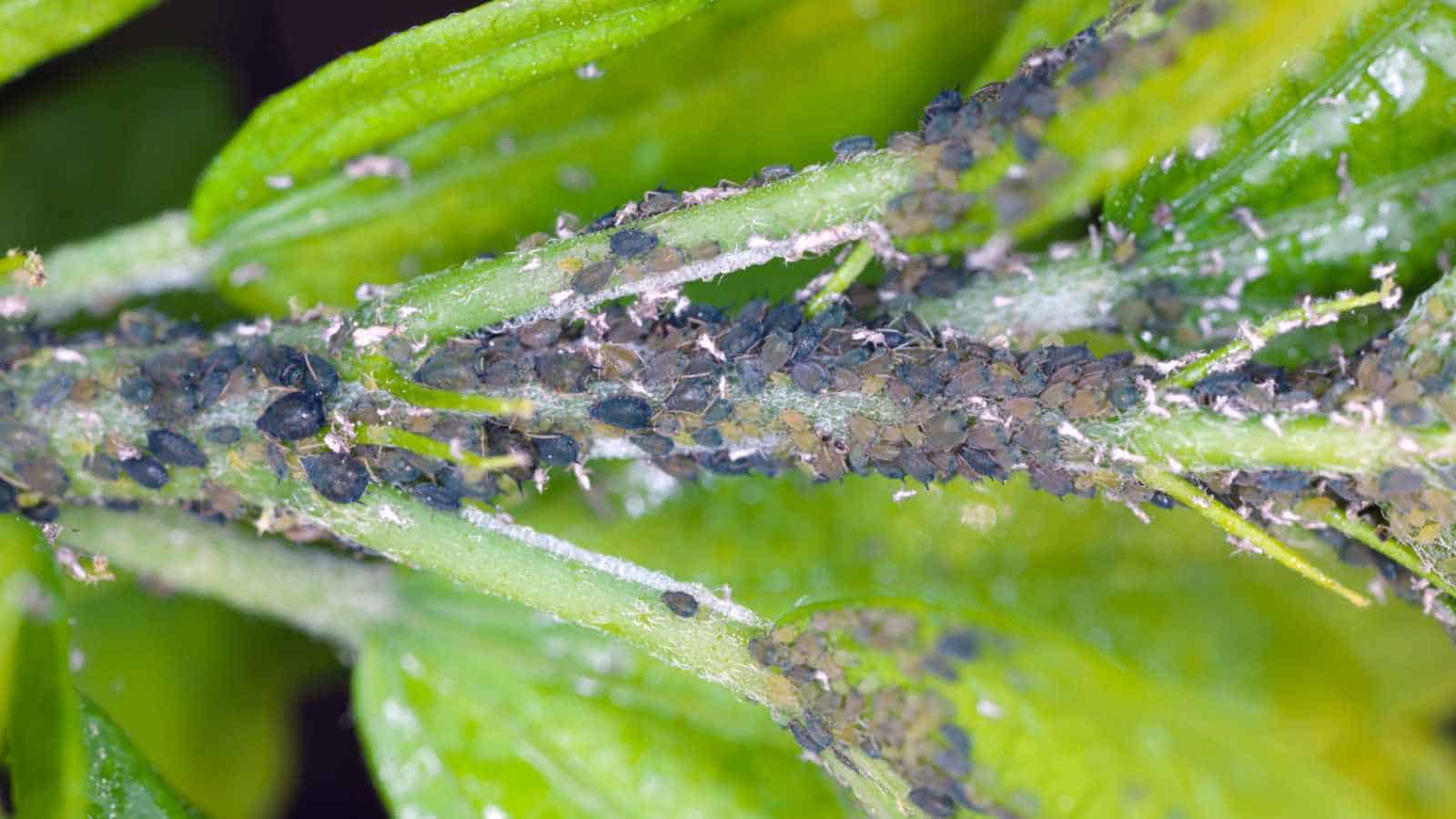
Aphids are small sap-sucking insects that can affect Rose of Sharon. They feed on the undersides of leaves, draining the shrub’s flowers and foliage of essential nutrients.
They are most prevalent in early spring, but their damage can linger throughout the growing season. These pests can stunt growth, cause leaf drop, and distort new growth.
You can manage them with insecticidal soaps or beneficial insects like ladybugs.
Whiteflies
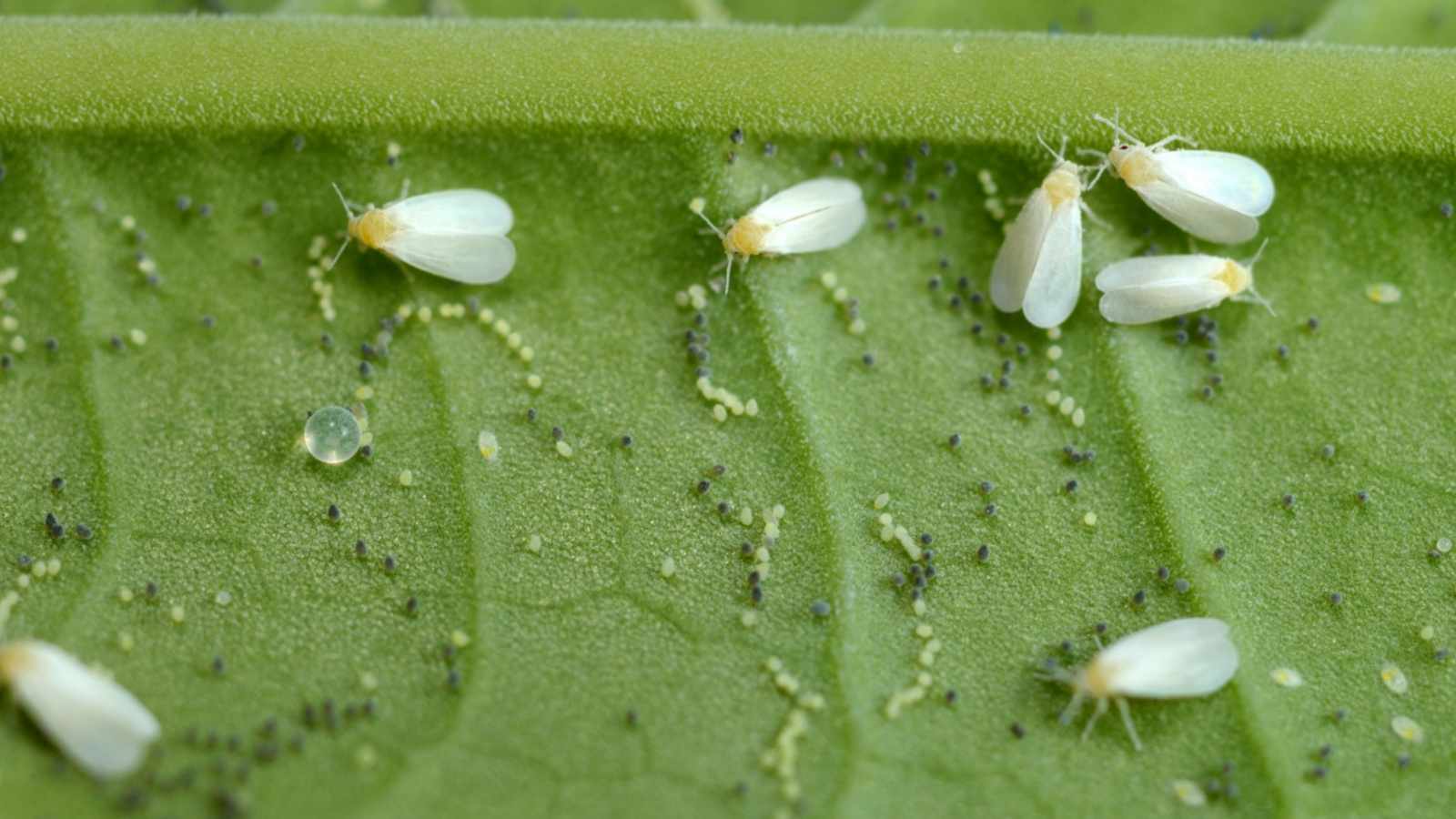
Whiteflies are another common pest, especially in the warmer regions where they can multiply quickly. They feed on the undersides of leaves, much like aphids, and can cause yellowing and curling as they feed on the sap.
The pest’s feeding harm can lead to significant damage, especially in a hedge or foundation planting of Rose of Sharon. Regular inspections and early detection can help manage these pests.
Fungal Leaf Spot
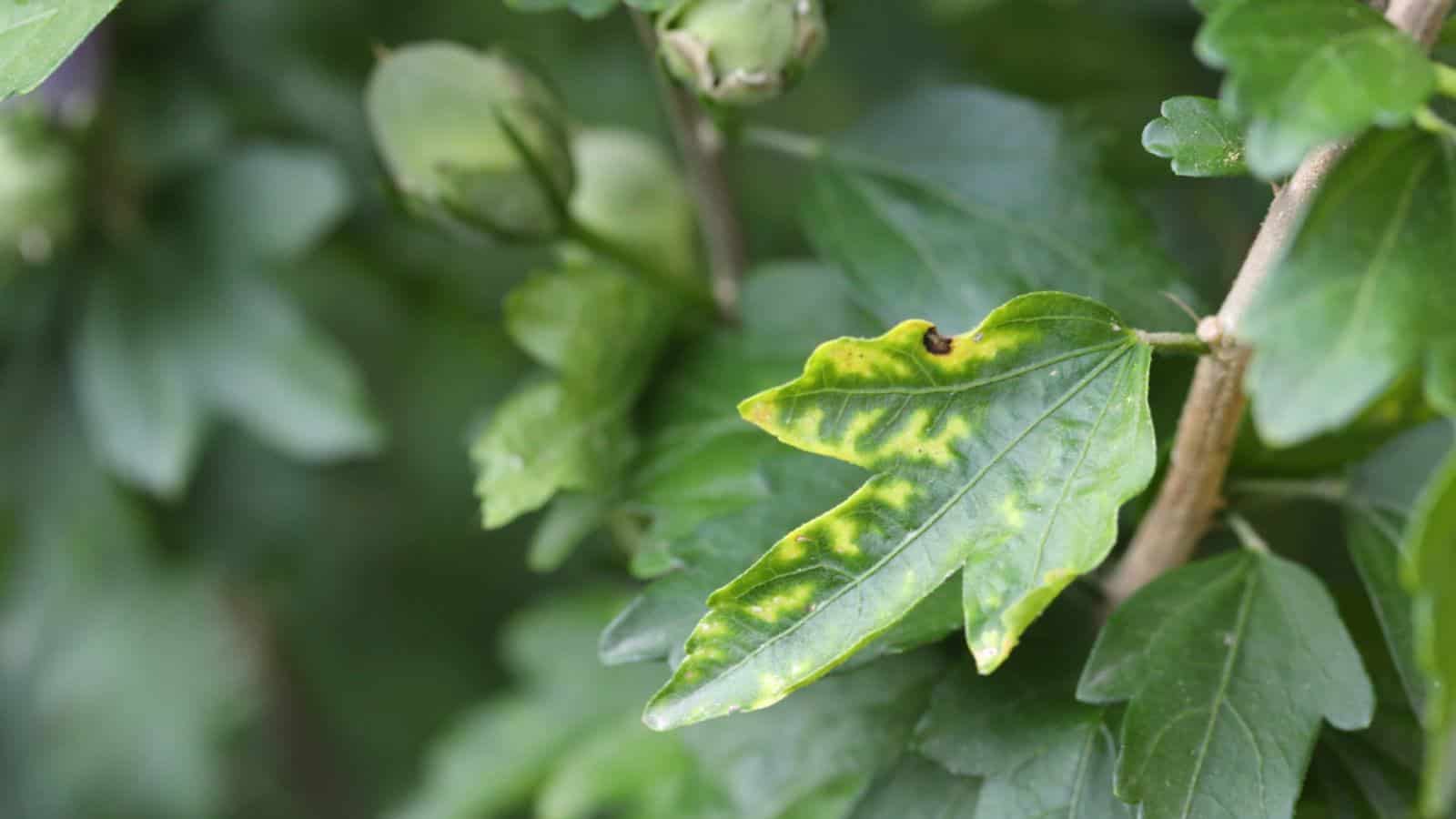
Fungal leaf spot is a common disease that affects the Rose of Sharon. This usually happens when the foliage stays wet for extended periods or in poorly draining soil. The leaves develop dark spots, yellow and eventually drop.
Keep your Rose of Sharon plants healthy by regular feeding with a slow-release fertilizer and ensure it’s planted in well-drained soil.
Botryosphaeria Canker
Botryosphaeria canker is a fungal disease that infects wounded or stressed Rose of Sharon shrubs. It can cause branch dieback and wilting leaves, eventually killing off entire branches.
Early detection and pruning out the infected areas is key to the management of this disease. It’s important to maintain good soil moisture around the root zone and ensure your plant is well-watered during periods of drought.
Blights
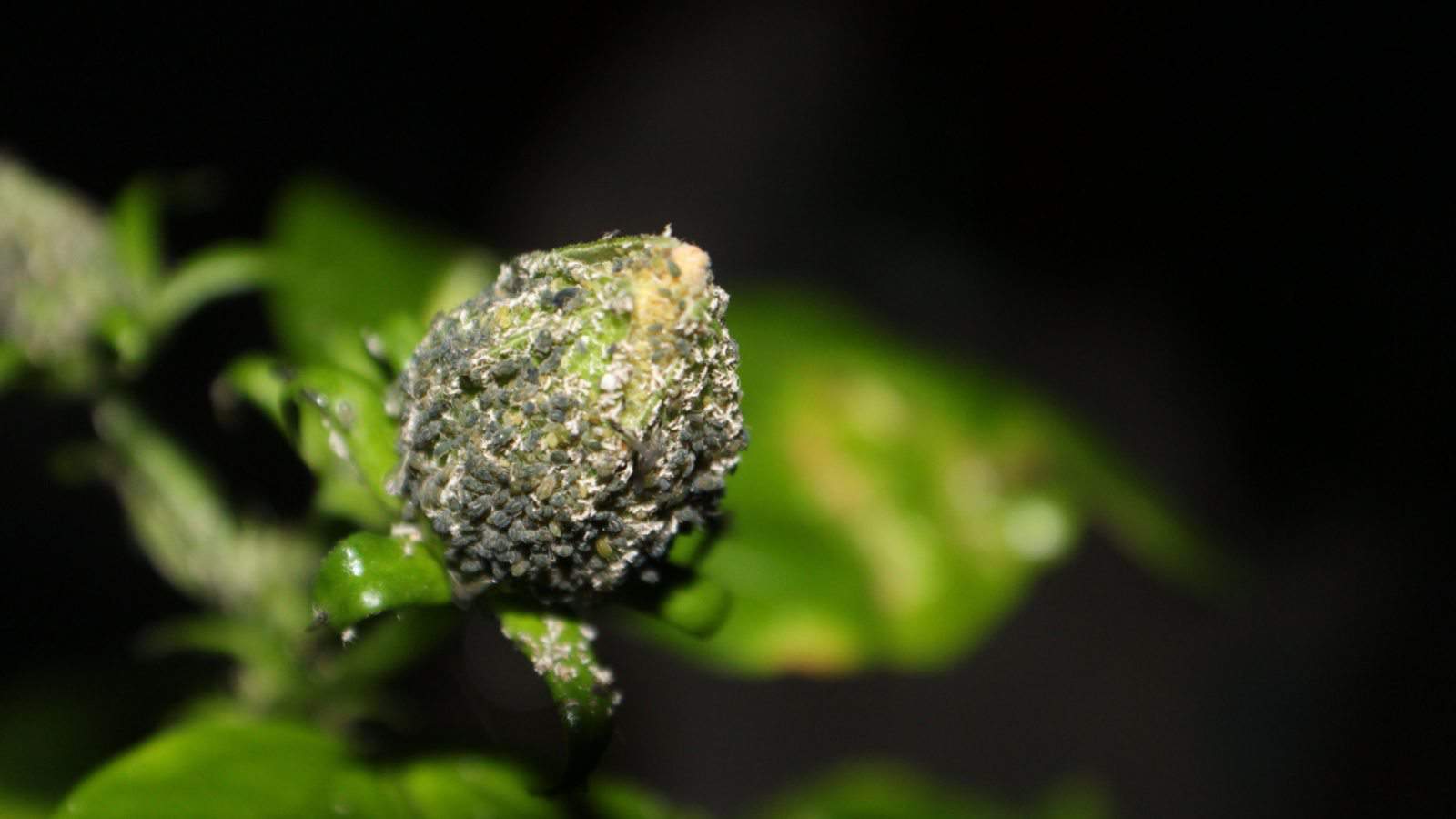
Both bacterial and fungal blights can affect Rose of Sharon plants. These conditions can cause wilt, cankers, root rot, and dieback. They often present as a discoloration of the plant, which then evolves into browning and wilting of leaves, blooms, and stems.
Proper plant placement in an area with full sun or partial shade, adequate spacing for air circulation, along with good watering habits, can keep these diseases at bay.
Common Plant Problems and Solutions for Rose of Sharon
Brown Tips on Leaves
Rose of Sharon is a hardy member of the Malvaceae family that often suffers from brown tip syndrome. This normally indicates a lack of soil moisture coupled with extreme heat.
To solve this, water the plant deeply at the root zone, ensuring the shrub is in well-drained soil to avoid waterlogged roots. Applying a layer of compost can also help maintain soil moisture, as well as deter weeds.
Yellowing Leaves
Yellowing leaves often signify poor soil nutrition or an aphids invasion. Aphids suck sap from the shrub’s leaves, causing them to discolor and curl. Use a mild insecticide or introduce natural aphid predators, such as ladybugs, into the landscape.
For nutrition deficiencies, a slow-release fertilizer applied in early spring should provide the necessary nutrients for the Rose of Sharon.
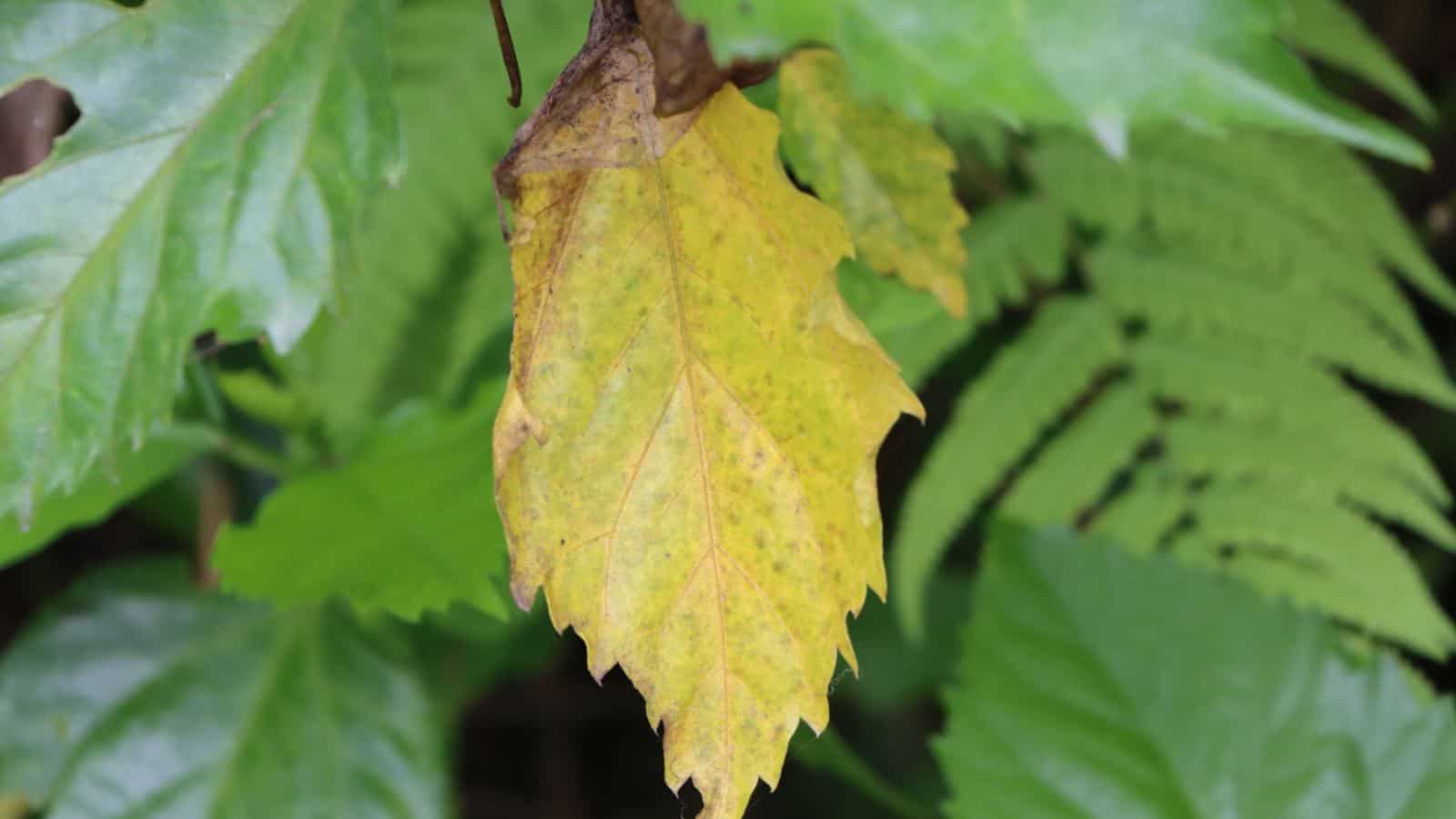
Failure to Bloom
Rose of Sharon, or shrub althea as it’s also known, has showy flowers that bloom in midsummer and sometimes fail to blossom due to incorrect lighting conditions or pruning at the wrong time.
Make sure your specimen enjoys at least 6-8 hours of direct sunlight. Additionally, do your larger pruning tasks in late winter or early spring before leaf buds and flower buds have formed.
Self-Seeding Becomes Invasive
Being a mallow that self-seeds, the Rose of Sharon can sometimes become invasive. If you find seedlings in unwanted areas, it’s best to remove and dispose of them while they are young.
Establish a neat hedge or foundation planting, which can help control the plant’s self-seeding habit, whilst creating an elegant border.
Other Flower Guides from Planet Natural:
Azalea Guide: How to Plant, Grow, and Care for Azaleas

